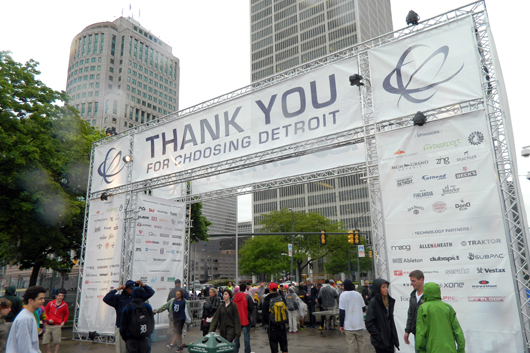XLR8R’s Five-Point Movement Festival 2013 Breakdown
Detroit’s annual Movement festival is something of a Mecca for fans of electronic music, especially […]
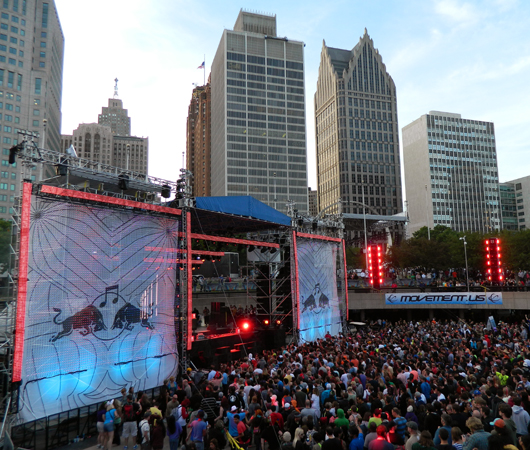
XLR8R’s Five-Point Movement Festival 2013 Breakdown
Detroit’s annual Movement festival is something of a Mecca for fans of electronic music, especially […]

Detroit’s annual Movement festival is something of a Mecca for fans of electronic music, especially those who have a fondness for its history and the integral part the Motor City has played in its development. It’s an event that has taken place every Memorial Day Weekend since 2000, and seems to have continually grown with each consecutive year, expanding its vision and curatorial approach. 2013 was no different, and from the moment XLR8R caught an early glimpse of Movement’s line-up for this year, we had our heart set on attending the festivities. Thankfully, the organizers obliged, and invited us out to spend the three-day weekend getting our fill of all the house and techno (and its many permutations) presented by the huge number of performing artists. Little did we know how much of an undertaking the whole experience would be, so we’ve decided to share a condensed, five-point breakdown of our time spent at Movement 2013.
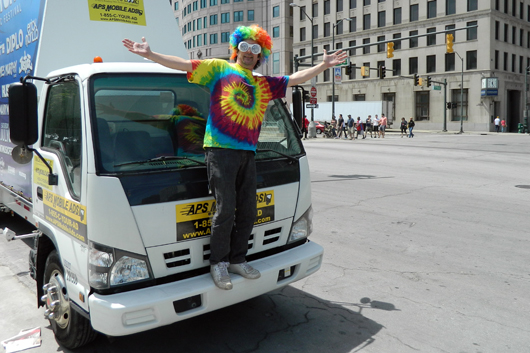
Movement is not for everyone.
Spread across three long days and nights, Movement is basically a litmus test for being able to take on a big weekend and survive all of the non-stop music, dancing, partying, and other assorted activities that entails. Performers are slated to start as early as 1 p.m. each day, and the list of DJs and live acts is evenly spread across each of the five available stages without stopping until around 11 p.m. or midnight. By that time, all of the official and unofficial afterparties are already underway, and most of them go at least until 4 a.m. It’s unquestionably a huge amount of fun, and offers true lovers of electronic music a chance to completely immerse themselves in the culture and sounds it offers for three straight days.
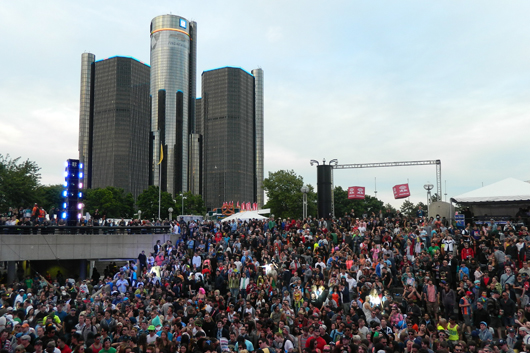
Benjamin Damage
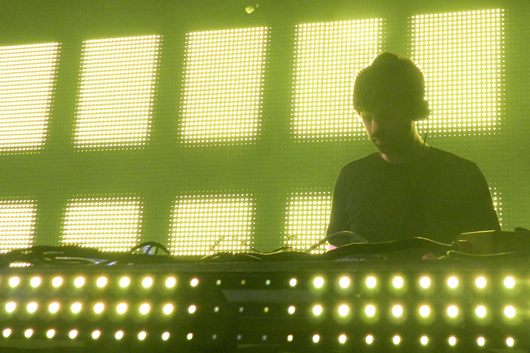
That said, Movement can turn into a bit of a grind. Since a lot of great artists are scheduled to play the earlier slots throughout Memorial Day Weekend, staying rested enough to catch their opening sets is something of a battle. We were lucky to see xxxy and T. Williams each warm up the festival with their excellent selections of bass-driven house and garage at the Red Bull Music Academy stage on opening day, but unfortunately only caught the last portion of Benjamin Damage when he kicked off the Underground stage on Sunday. Having stayed out the night before watching practically the entire Dirtybird crew bring its brand of raucous party music to The Fillmore and catching Kyle Hall drop some smoothed-out disco and house selections at the homegrown Deep Detroit Five afterparty, we took a bit longer than usual getting ourselves over to Hart Plaza to hear Damage’s entire set of dark and heavy techno. All of which is to say that the full Movement experience really isn’t for people who are interested in getting a full-night’s rest and taking time to wander about seeing the sights of Detroit. There are so many top-notch artists and events crammed into the three-day weekend, and very little of it is worth missing.
Moodymann
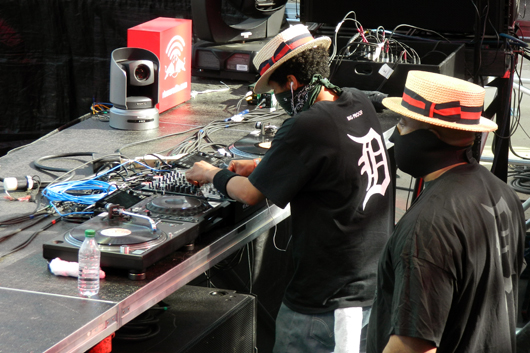
Ellen Allien
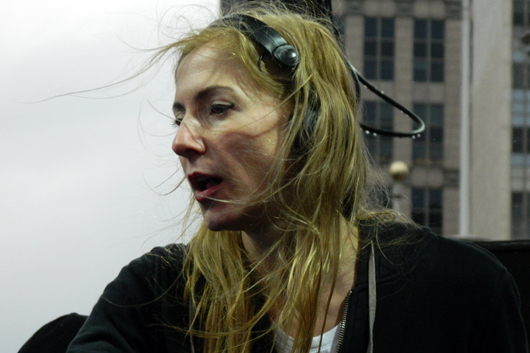
Movement is for everyone.
For better or worse, Movement is open to literally everyone, and as such, often feels like one massive, all-ages club. The youth contingent was apparently stronger than ever in 2013, and they often appeared to be the most enthusiastic of the festival attendees, too. Whether they were crammed up against the barriers at the Beatport stage (where Ellen Allien kept everyone continually hyped with her non-stop dance moves and Masters at Work played a glut of big-room house tunes to an immense audience) or crowdsurfing to Body High co-owner Samo Sound Boy‘s slick, bass-focused set of forward-thinking club jams at the Electric Forest stage, the youngsters made up most—if not practically all—of any given throng of people undulating in front of a stage.
Masters at Work
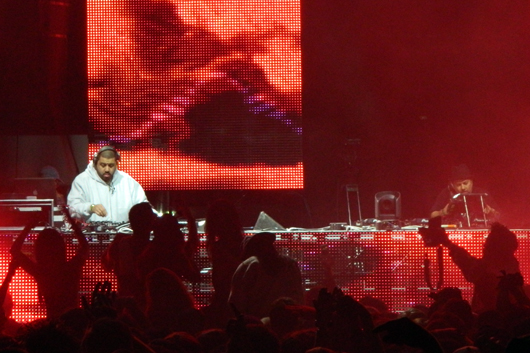
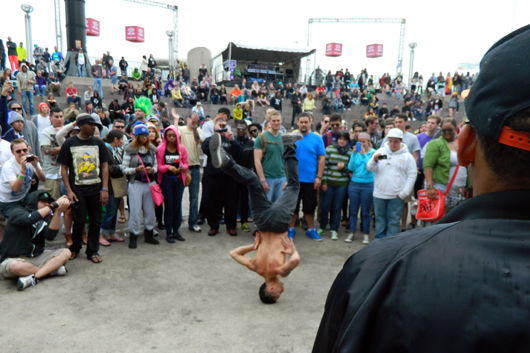
Though it often seemed to be, Movement wasn’t just a seething mass of teenagers decked in neon, sporting furry hats or boots, and/or wearing next to nothing. It was also full of industry types, aspiring artists, longtime local supporters, curious passersby, breakdancers, young professionals, babies, vacationers from around the world, chess players, and more. The festival’s diversity was more apparent during the daytime, when there was space for dance circles to form and people could move around leisurely without having to dodge running tweens or stumbling drunks. But by nightfall, Hart Plaza was packed with partiers of all ages, many of which seemed to be treating the music as more or less a backdrop to their attempts at getting wasted and dry humping the person nearest them. While we were keeping our focus on the massive sub frequencies and grimy riddims of The Bug‘s performance on Saturday night, the rest of the crowd seemed to be in a contest to see who could out scream and out flail one another. If we’re being honest, it was a fairly entertaining spectacle to watch (The Bug himself called it “the war against brostep”), but the excellent visuals provided by the stage producers were already more than enough ocular stumuli. And yet despite such distractions, the fact that Movement remains an all-ages festival is very much a positive thing, as it opens up the possibility for the performing artists to enlighten and entertain all kinds of people. We’re just glad that some of the festival-goers couldn’t get into most of the afterparties.
The Bug
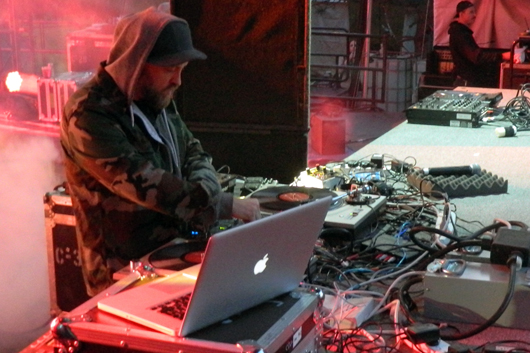
Nicolas Jaar
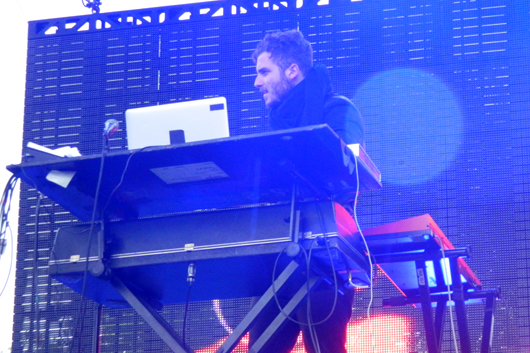
Shigeto
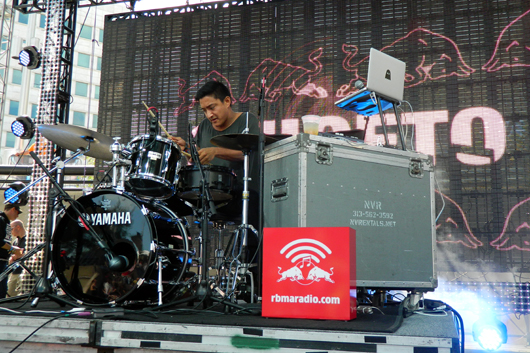
If the sun (or rain) gets to be too much, go Underground.
This year, Saturday and Sunday were very warm and sunny days. And even though Monday brought a full day’s worth of rain to the weekend, if attendees arrived in Detroit without a tan, there’s almost a 100% chance that they left with one (or, more likely, a sunburn). So, yeah, it got really hot sometimes while watching artists like Shigeto and Onra deliver body-moving beats on the main stage (not to mention a bit soggy when Dabrye and Nicolas Jaar played their sets in Memorial Day’s afternoon drizzle), and there wasn’t a whole lot in the way of finding shade except to take shelter in the cavernous Underground stage. Thankfully, loads of quality DJs and producers—like Ben Klock, Deadbeat, Silent Servant, and Nina Kraviz, to name a few—played there, and kept the incessant energy of the echoey room to a level somewhere in between an illegal warehouse rave and that huge, tribalistic dance party scene in The Matrix Reloaded. However, that also means that the area was at an almost maxed-out capacity pretty much around the clock, which made getting from one place to another extremely difficult and frustrating. But no matter—wherever we found ourselves once we took shelter at the Underground stage, there was never a shortage of dancing bodies surrounding us, and we quickly got into whatever hypnotic strain of techno was being pushed into the darkness from the glowing, monolithic stage.
The crowd for Nina Kraviz
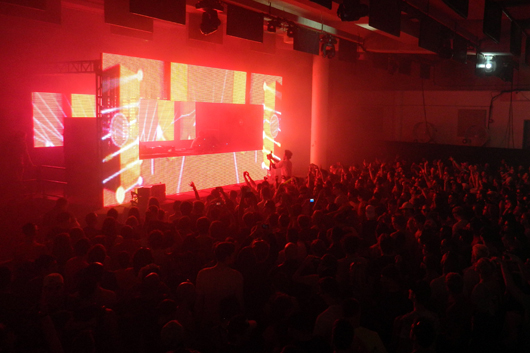
Dabrye
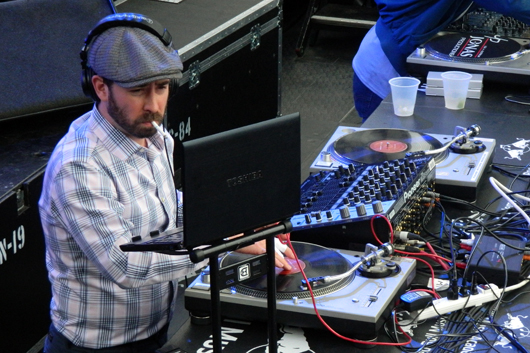
Never miss a chance to see Terrence Parker, Mala, or Azari & III.
While Movement’s lineup this year was chock full of XLR8R favorites, the performances which stood out in particular came from Detroit’s own Terrence Parker, UK dubstep lynchpin Mala, and the four-piece live band of Azari & III. Why these artists wound up as our ultimate festival highlights was due to a number of different reasons, but if we had to boil it down, we’d say that it was essentially because of their showmanship and selections.
Terrence Parker
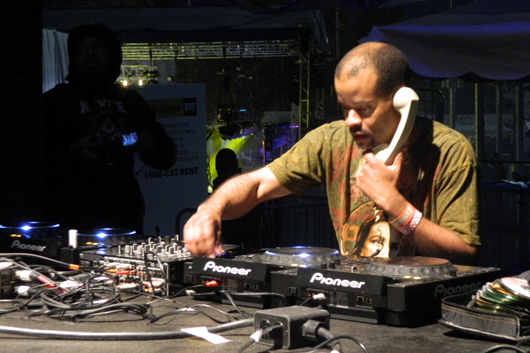
All of the DJs we saw at Movement were quality selectors who crafted coherent and moving sets with an array of different genres of dance music, and yet Terrence Parker and Mala stood tall above the rest. On opening night, the Motor City native took the headlining slot at the Made in Detroit stage, and with his signature telephone receiver in hand, delivered a performance that could only be described as “awe-inspiring.” Parker whizzed through loads of vintage house and techno tunes, inspiring cheers of adoration and flurries of applause when he dropped classics like Inner City’s “Good Life” and “Percolator” by Cajmere. The DJ also dabbled in some bits of old-school electro and breezy, disco-flecked cuts through the night, scratching and beat juggling like a madman without a care in the world. Just about everything he did was met with some kind of expression of amazement from the overjoyed onlookers, and it was sometimes hard to tell if Parker or his audience was dancing the hardest.
Terrence Parker
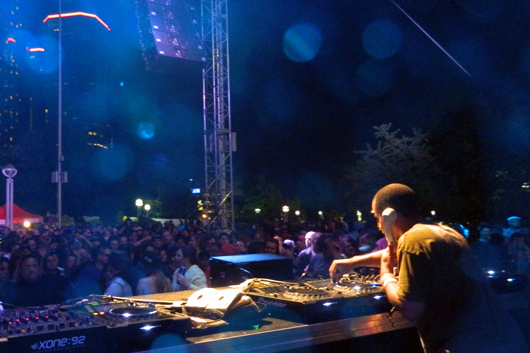
Mala
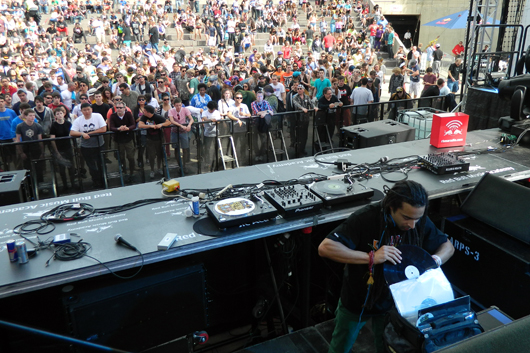
During the next day, Mala was tasked with an afternoon slot at the RBMA amphitheatre following a particularly bombastic and, at times, borderline unlistenable set from DJ Hatcha. (Needless to say, the mass of EDM fans at Movement were eating up his selections.) So when the longstanding dubstepper started off his hour-and-a-half mix with a 12″ of dusty reggae, the crowd’s attention immediately started to wane. But much in the same way that Mala’s first record eventually flipped into an outright jungle track, the energy of the people surrounding the main stage wound up growing exponentially. Each of the sub-heavy cuts being pushed through the main stage’s massive soundsystem sounded absolutely overwhelming, and the selector was having a blast dropping every one of them. He danced around flapping the records with excitement and laughing to himself or with friends watching from onstage. The Bug, who stuck around the festival after his own set on Saturday, looked on while Mala played the hyped-up audience his new “Dirty” tune, making everyone on and around the stage bob their heads and vibe with The Bug’s heavy production and Flowdan’s raw lyrics.
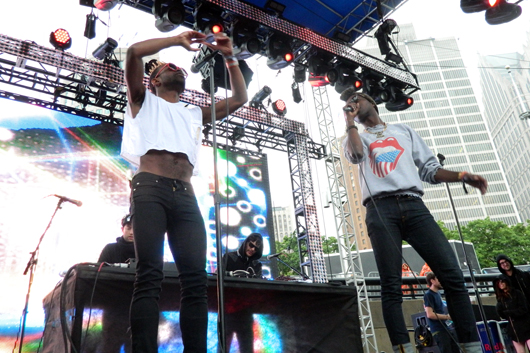
Azari & III
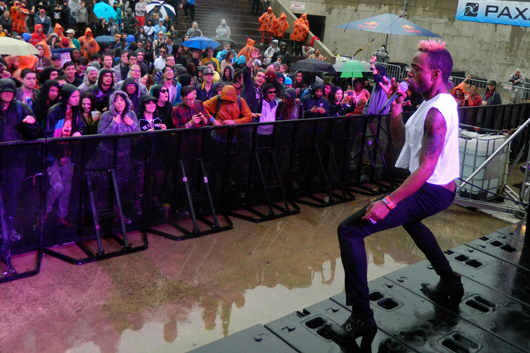
Azari & III provided Movement with a phenomenal live set during the late afternoon on Monday. By that time, the morning’s drizzle was on its way to becoming an all-out downpour, but none of that hindered the band’s intensity or the uninhibited enthusiasm of its fans. The quartet ran through big-room renditions of its hit singles—”Reckless (With Your Love)” and “Manic” proved to be especially outstanding—and a few of the more industrial-tinged instrumentals from 2011’s Azari & III, while Dinamo Azari and Alixander III each manned a pair of CDJs in the back and the pair of vocalists ran around the stage dancing and climbing on the various platforms around them. And even though the band didn’t have as big of an audience as, say, Richie Hawtin or Squarepusher did on the same stage, Azari & III’s pumping, non-stop house rhythms and infectious energy seemed to captivate its crowd more thoroughly than any of the other performers.
The stage during Squarepusher
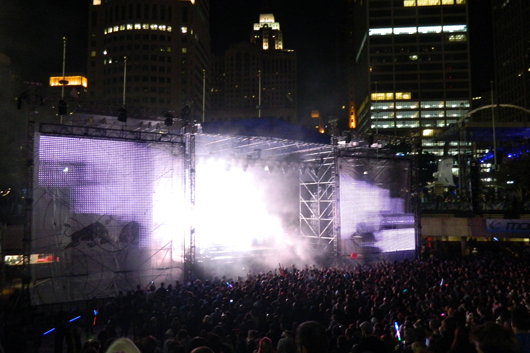
Samo Sound Boy
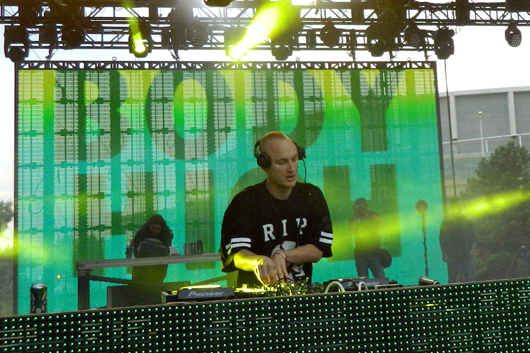
Afterparty scheduling is more important than daytime scheduling.
Even though there are a myriad of exciting artists playing at any given moment on one of the five stages spread across Hart Plaza, it’s all in such convenient proximity that the only thing to worry about is having to split time between favorites. While we were in the middle of getting down to Samo Sound Boy’s tunes at the Electric Forest stage on Sunday, Matthew Dear was playing a live set as Audion less than a five-minute walk away on the main stage. Not wanting to miss too much of this rare occasion, we could only wait for 30 minutes or so before heading over to indulge in Dear’s punishing techno grooves and their arresting visual accompaniments. That kind of overlap wasn’t a constant issue, thankfully, and we largely were able to see whatever performance we desired. As such, on the festival grounds there wasn’t much scheduling that a quick, last-minute glance at the program couldn’t take care of, but the same could not be said for the Movement afterparties. Granted, most of the afterparties that go on in Detroit during Memorial Day Weekend are unofficial, and so ease of access, guaranteed entry, and overall quality of the events are not the responsibility of the festival organizers—which actually makes an afterparty schedule all the more important. Checking out the location of the party before buying a ticket is essential, as reliable transportation is not always guaranteed. There were a number of different events we had our eyes on this year that seemed to be simply out of reach, so we stuck to a few in the Downtown Detroit area.
Audion
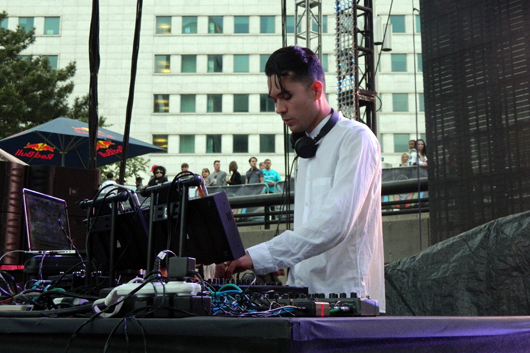
Dennis Ferrer
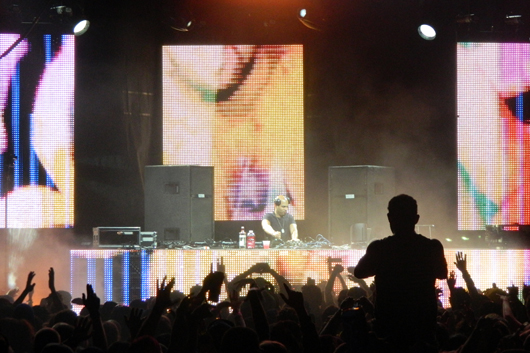
But even jumping around a handful of events proved to be problematic. We had our heart set on hearing a set from Basic Soul Unit, so we made sure to catch him Sunday night at Motor City Wine. In the intimate balcony space, the Toronto DJ played a stellar mix of raw hardware funk and acid—a major highlight of which was Pépé Bradock’s “Lifting Weights”—to a sparse but enthusiastic crowd who danced around the dimly lit space sipping wine and beer. We’d hoped to split our night between that smaller party and the bigger line-up down the street which included Maceo Plex, James Holden, and Magda, but things weren’t so easy. When we arrived outside of St. Andrew’s Hall around 1 a.m., a sizable crowd was outside of the venue, some of them attempting to stand in an orderly line and others doing all they could to finagle their way to the front. We did our due diligence and waited outside for close to an hour, keeping our eye on the prize while arguing with our better judgement against walking away. But when we got to the front of the maddening crowd, our position was usurped by a large group who had just appeared off the street, and all of this after we were told the venue was already at capacity. No party was worth enduring that kind of shoddy organization, so we took our business elsewhere (deciding later that sticking to one afterparty a night would probably be the best the way to go). Thankfully, the streets of Detroit were overflowing with locals and festival-goers alike, everyone dancing and vibing to the soulful sounds of house and techno wherever they happened to be, and we were more than happy to join them.
